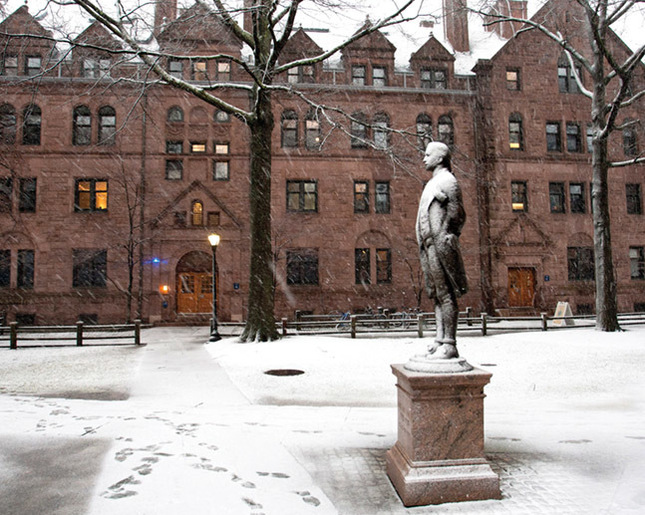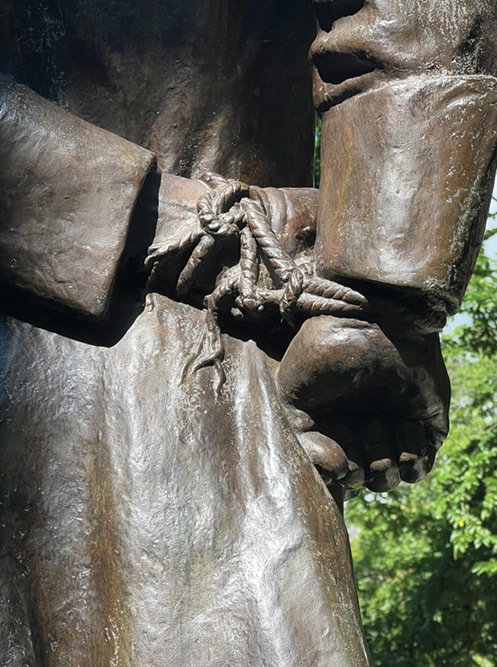
Jack Devlin ’22
With no life portraits on which to base his work, Pratt strove for historical accuracy in his sculpture of revolutionary war hero Nathan Hale. It was created more than a century after Hale was executed by the British.
View full image

Jack Devlin ’22
With no life portraits on which to base his work, Pratt strove for historical accuracy in his sculpture of revolutionary war hero Nathan Hale. It was created more than a century after Hale was executed by the British.
View full image

Nathan Hale stands with hands and feet bound in this sculpture by Bela Lyon Pratt, Class of 1887. The Hale sculpture has stood in front of Connecticut Hall since September 1914.
View full image

Nathan Hale stands with hands and feet bound in this sculpture by Bela Lyon Pratt, Class of 1887. The Hale sculpture has stood in front of Connecticut Hall since September 1914.
View full image
Nathan Hale, Class of 1773, was twenty- one in 1776, when he was hanged by the British as a spy for the American army. The Connecticut schoolteacher, who had studied at Yale, enlisted at the outbreak of the Revolution. He is most remembered for his bold last words: “I regret that I have but one life to lose for my country.”
Over a century later, Yale commissioned a life-sized statue of its youthful martyr as a model of sacrifice and idealism for students, many of whom were (and are today) the same age as Hale at the time of his death. According to the Springfield Republican, artist and alumnus Bela Lyon Pratt, Class of 1887*, was commissioned in 1899 to create the image in honor of the university’s 200th anniversary in 1901, in competition with his mentor, Augustus Saint-Gaudens. He also created a commemorative medal. Without enough time to complete the portrait before the anniversary, and in light of a later, competing effort to hire sculptor William Ordway Partridge, Pratt abandoned the project. His initial plaster study would reside at the Yale School of Art for over a decade, until Partridge withdrew in 1911. At last, Pratt took up the project again and installed it by Connecticut Hall—the only surviving Yale building from Hale’s time—in September 1914.
In Pratt’s sculpture, Hale stands with his hands and feet bound, a pose inherited from Frederick MacMonnies’s 1893 monument for City Hall Park in New York, where Hale was then thought to have been executed. Both sculptures strive for historical accuracy, though there were no life portraits of Hale from which to begin. Modeled on a related descendent, Pratt’s is the more reserved: his clothes plain, pose still, hands together, and hair ordered. Such modesty was the attribute that contemporary critics admired in much of Pratt’s art. At the time of its installation on campus, news accounts pointed to the subject as a model for Yale students—a perennial peer and friend. Rather than amplifying the bravado of Hale’s last words, Pratt had created a portrait of a fresh-faced young man whose upright stance and fisted right hand signaled his resolve. Here was a young person to whom Yale students could relate, presented near life-size on a simple, low pedestal.
When Pratt had finished his own studies at Yale, he moved to New York to study at the Art Students League, and then worked as an apprentice for America’s leading public sculptor—Augustus Saint-Gaudens—before moving to Paris to study at the École des Beaux-Arts. His mentor’s influence would be lasting. Pratt embraced the vitality of surface and pose that became hallmarks of American public sculpture during its golden age. At Saint-Gaudens’s invitation, Pratt returned to America in 1892, to participate in the World’s Columbian Exposition in Chicago the following year. The exposition launched the careers of many public artists, including Pratt. He settled in Boston and taught modeling at the School of the Museum of Fine Art until his death in 1917, soon after completing the Yale commission.
The Hale sculpture’s afterlife has been notable. Three years after its installation, as a new generation of soldiers prepared to leave the campus for service in World War I, two of them posed for a photo by the Hale sculpture. It appeared on the cover of the Yale Alumni Weekly. Since World War II, the popularity and mystique associated with military intelligence have further endowed Hale’s portrait with an extra dimension, owing to the service of later Yale alumni. As the nation’s bicentennial approached, a copy of Pratt’s sculpture was cast for the museum of the Central Intelligence Agency, where it remains “a continuing reminder to its employees of the duties and sacrifices of an intelligence officer.”
__________________________________________________________________
*Pratt graduated from Yale’s School of Fine Arts in 1883, but the school didn’t start giving degrees until 1891. He received his diploma in 1899.
 loading
loading